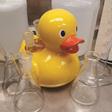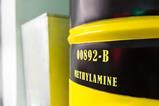Four eyes (or 10 eyes) are better than two
‘Whatever can go wrong, will go wrong’ is a classic aphorism. It applies just as well to chemistry as it does to other, less scientific endeavours. Your laptop computer will run out of battery life during an important job interview, or you’ll reach in the lab refrigerator and find out that the n-butyllithium you carefully titrated last week has been used up by your good-for-nothing labmate. Worse yet, it is almost guaranteed that, no matter how careful you are, you too will end up making errors in the laboratory.
I don’t think I’ve made very many serious errors in the lab, but I do remember the time in graduate school that I was performing a crucial lithiated alkynylation to an aldehyde, and I failed to put in the alkyne. That was particularly grim, not least because of the many hours I had spent making the aldehyde. That I had decided to run this reaction in the middle of the night surely had nothing to do with my error. I also remember that I discovered this mistake about three seconds after I closed my eyes in bed, and that I tried to make up for it by rushing back to the lab to start the laborious aldehyde synthesis in the early morning hours all over again.
When you’re manufacturing chemicals on the hundreds of kilogram scale, you don’t run crucial reactions in response to panicked mistakes. Instead, you work within a system that is designed to prevent basic errors. We’ve all made stoichiometry miscalculations in our laboratory notebooks, but I bet you’d make fewer of them if you had someone else independently check your working. I’d bet even more errors would be caught if your labmate’s signature had to be on your lab notebook page before you ran your reaction.
I always imagine a QC chemist as a border control officer
It’s not just the maths that gets checked. When chemicals arrive at our facility, the material is checked against our order systems to make sure that we actually ordered what is on the truck, and that the paperwork carried by the driver matches the labelling on the containers being delivered. The containers are then taken into our warehouses and set aside with special stickers that mark the material as unable to be used prior to testing.
Samples of chemicals are checked for quality, of course, but more simply, they are checked for identity. I always imagine a QC chemist as a border control officer, holding up an IR spectrum like a passport to see if it matches that of the chemical in front of them. This feels like paranoia, but, as the old adage goes, even paranoids have enemies. I once ran a number of reactions on a starting material unsuccessfully, and then I finally checked that starting material against a known NMR of the material. I knew there was something wrong when the purported starting material wasn’t dissolving in deuterated chloroform, which it was supposed to!
Once the material has been approved by the QC laboratory for use, the containers are physically labelled as approved. When it is time for those materials to be used, our warehouse managers will stage the approved drums in their appropriate place in the plant. Operators don’t go into the warehouse and pick out starting materials and solvents – rather, drums are placed in their correct spot to prevent another source of error.
Finally, when it is time to actually run the reaction, there is one more layer of checking. Prior to the drums being charged to the reactor, there is an identity check to make sure that the labels on the drums match what is called for in the batch record. In addition, we have a second person agree that the correct material is being charged to the reactor.
Is this all a bit paranoid? It can feel that way! However, the consequences of adding the wrong reagent or the wrong starting material at the wrong time can be so damaging. As a simple example, in 2020, the Japanese drugmaker Kobayashi Kako admitted to accidentally mixing a sleeping aid medicine into antifungal tablets. This resulted in the death of a woman in her 70s and affected hundreds of other patients; the contaminated pills were also linked to 15 traffic accidents. There were systems in place – the drums for the different medicines were in differently shaped containers and clearly labelled, but the lapse happened when a single worker was working instead of the two operators the procedure called for. Two pairs of eyes may not catch every single mistake, but they are better than the risk of working alone.

















1 Reader's comment